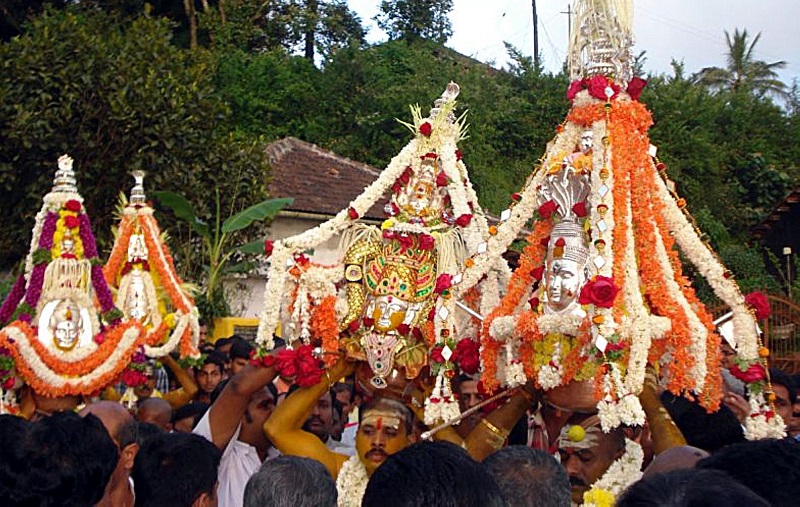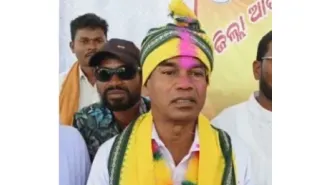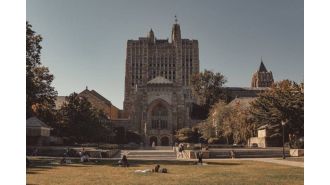Importance of Karaga Utsav
Importance of Karaga Utsav

Madikeri, Sep. 21: Madikeri's historic Dasara festival has a history of hundreds of years. The Karagas of the four main Shakti deities of the city play an important role in this festival. The four Karagas have their own history.
Here is a brief introduction to the construction of the Karagas that participate in the Karaga Utsav, which begins every year on the day after Mahalaya Amavasya during the Dasara festival.
It is believed that the Karagas of Kundurumotte Sri Chauti Mariyamma Temple, Dandina Mariyamma Temple, Kote Mariyamma Temple and Kanchi Kamakshiamma Temple in Madikeri city go for a city tour after the puja ceremony on the day after Mahalaya Amavasya.
The day after Mahalaya Amavasya, after the Rahu period, the Karagas are released in the morning in the temples of the four Shakti deities. After Ganapati Homa and Puja, the goddess's mask and necessary silver ornaments are placed and purified. Various puja materials required for making the Karaga, such as turmeric, saffron, betel leaf, turmeric, black seed, bangle, mirror, turmeric powder, mango leaves, coconuts, bananas, etc., are added and placed in a new kukke.
Then, the priests carrying the Karaga perform the puja with devotion and then, with the accompaniment of musical instruments, they leave the temples for the Pampinakere.
In the Pampinakere, raw sand, turmeric, black seed, bangle, mirror, betel leaf, lemon, turmeric, saffron, and a Rs. 5 coin are placed in the pot for making the Karaga. Then, mango leaves and coconuts are placed on top of the pot and a kalasa is tied. Then, it is decorated with flowers. On this occasion, the bamboo basket is placed in the bindige, covered with banana leaves and tied with rope. Then, the karagas are prepared by wrapping the jasmine or chrysanthemum flowers required for decoration on the respective karagas and putting on the silver mask of the goddess and ornaments on the top. A garland of danda is tied around the four corners of the bindige and lowered. Roses are placed where necessary on the bindige. The priests carrying the karagas take a bath, put on their loincloths and offer worship to the karagas through the priests.
Reason for releasing the karagas?
About 200 years ago, when terrible epidemics were raging in Kodagu, there were many deaths and injuries every day. As people were afraid of this, they left their villages in Kodagu, and the villages were empty. The citizens, who took this seriously, gathered at the Bhajan Mandal of the respective temples and the leaders of Madikeri city to pray to the gods. The goddess herself appeared and, on the next day of every Mahalaya Amavasya, carried the kalasa of four sisters and brothers and went to various parts of the city for 10 days, accepting the worship offered by the devotees and responding to their hardships. As per the word of the goddess, the elderly citizens of the town gathered at the Bhajan Mandal. Thus, they got ready to release the Karagas of that day.
It is believed that in the past, the kings of the Haleri dynasty used to go to Dandi on the day of Vijayadashami during Navratri and cut the ‘Banni’.
After all the work was completed, after the mass puja was performed, the priests would place the Karagas on their heads. By then, the deities would cover their bodies and all the deities would speak in Tamil. As they move towards the main road, the people on both sides of the road offer their devotional prayers to the goddesses. A few years ago, the floats would offer their prayers at the Basaveshwara Temple and the Chowdeshwari Temple, then proceed to the Peta Sri Rama Mandir, rest there for some time, and then proceed to their temples. Now, as they leave Pampinakere and receive prayers from their homes, they go to the Sri Kodandarama Temple, receive prayers, then come to the Basaveshwara Temple, and from there proceed to the Peta Sri Rama Mandir as before for the Chowdeshwari Temple.
From the next day until Navratri, the The Karaga goes to the houses of various areas of the city and receive prayers.
Disclaimer: This article has been translated by xklsv.com using advanced AI-based translation tools. Please note that the use of AI for translation is still experimental and may not be 100% accurate. The original content is sourced from shakthidaily.info, and Shakthi Daily is not responsible or liable for any errors, omissions, or inaccuracies that may appear in the translated version, including spelling, grammar, or contextual misunderstandings.If you come across any mistakes or inconsistencies in this translation, we kindly request you to report them by sending an email to [email protected] . Your feedback will help us improve the quality of our translations.






